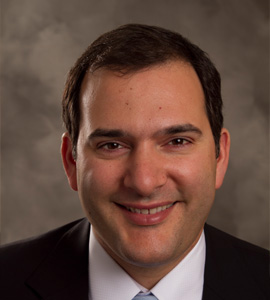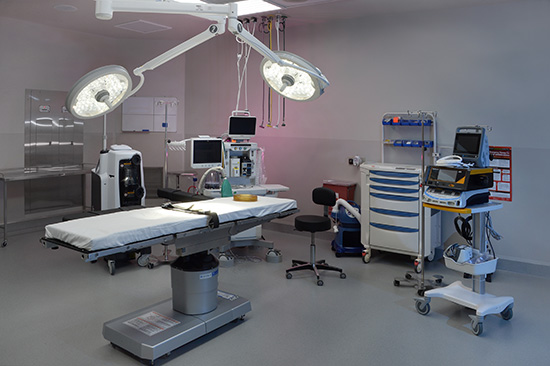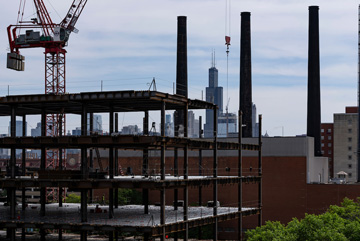Choosing the right equipment, educating surgeons and planning for controlled growth are all part of the process.
 Credit: Snibbe Orthopedics
Credit: Snibbe Orthopedics
Dr. Jason Snibbe.
Taking the plunge to build or renovate and outfit an ambulatory surgery center takes a lot of thought and planning. With so much at stake for the entire team, from stakeholders to owners to staff, selecting
a partner to take the journey is critical. Dr. Jason Snibbe, a board certified orthopedic surgeon practicing in Beverly Hills, offers some insights into the process for an orthopedic facility and how to approach the goal of
launching a new ASC in the community.
Q: Outfitting an ASC is a big project. What do you think the biggest challenge is when starting a new ASC or undertaking a renovation?
The biggest challenge opening an ASC is the upfront cost of all the capital equipment
and disposable equipment. It takes a large investment to get the ASC ready for surgery and procedures. It is important to unify the physicians so there is limited duplication of equipment and implant companies. This unification
can allow an ASC to drive down costs and create efficiencies. This also makes the staff less confused when common cases are scheduled with different surgeons. For example, using Stryker for all joint replacement surgeries creates
a streamlined efficiency for the staff and surgeons.
Q: What do you think surgeons should look for in an equipment and solutions provider when starting a new ASC, undertaking a renovation or financing equipment?
When an ASC is selecting a capital/equipment provider, the
essential part is a global contract. An ASC should select a company that has quality products that can be used for a variety of procedures. For example, arthroscopy towers, power equipment, surgical robots, sports medicine
and arthroplasty implants and sports medicine tools. A global company that can provide all of these products can be very creative with financing and rebate programs. This allows a company to provide up front capital and disposable
products at a discounted cost. As the ASC grows, rebate programs can be expanded to other products or locations. This can be a very powerful tool to fuel growth.
Q: What would you say are the top three things to keep in mind as the project progresses?
The top three things to keep in mind as the project progresses, first is the surgeons. The culture of the ASC is critical to
its survival. Surgeons are the engine that drives business in the center. The ASC management, either physician, hospital or corporation, should always be in close communication with the surgeons. Always listen to what they
need now and in the future to allow for growth. This growth should be in the form of increased cases from existing surgeons and encouraging the recruitment of new surgeons. All of the surgeons should meet regularly and keep
a transparent view of the workings of the ASC.
The second thing to keep in mind is that this is a business. A business is primarily for making money. The surgeons should all be educated in the structure of how an ASC makes money, the overhead structure and understanding the
billing process. Physicians do not have any training in this. As owners of the ASC, the surgeons should come together and educate themselves on the business of the ASC. This creates a culture of understanding and avoids surgeons
feeling like they are being taken advantage of. This also stimulates a structure where surgeons want to help drive down the overhead and increase profits. Keeping surgeons in the dark is never a good idea.
The third is have a one-year plan for the first year. Avoid the temptation to buy too much equipment that is not needed. Create goals for the first year as well as the next several years. It is helpful to create surgical volume
goals and cash flow goals. This will help control costs and prevent the ASC from costing too much at the beginning. As the volume grows, the ASC can buy more equipment and expand the surgical cases. For example, start an outpatient
total joint program but start with a lower volume. Then slowly expand the cases to a higher volume to allow the staff to learn systems and surgeons preferences. This creates less stress on the system and allows the growth to
be efficient and controlled.
Q: What factored into your decisions about equipment for your ASC specifically for the service lines your ASC offers?
My decision for equipment centered around robotic total joint surgery and quality equipment from
a global company. Instead of using multiple companies with different contracts and sourcing, I used one company that had the majority of the equipment I needed and had the premier implants as well. I also wanted to use the
best robot in the market that would provide excellence in outcomes and patient safety. In my opinion, the only company that can fulfill these goals is Stryker. They are truly a leader in so many facets of the business and can
provide excellent product, capital equipment and service. Stryker created communication lines between product divisions that allows a global rebate and contract system. This allows different implants, disposables and capital
purchases to be under one contract, so rebates can be across many divisions.
Q: How does your ASC benefit your local community?
Our ASC benefits the local community by providing excellence in orthopedic, spine and pain management. The global pandemic created a fear of hospitals and created a
desire for patients to want procedures performed in ASCs. The pandemic heightened the understanding of how safe an ASC is but also how elevated the patient care is. Patients continue to have better outcomes objectively and
subjectively at an ASC. The community continues to support our ASC because we can perform complex cases with accuracy and safety. Patients drive business to the ASC by communicating to friends and family regarding their experience.
Q: What advice would you give to someone before they decide to go build, or renovate/expand an existing facility?
The best advice is to create a strong core of surgeons that have a common goal. The key to success is
surgical volume and surgeons that drive business to the ASC. There should be transparency in the volume and revenue so all the surgeons can hold each other accountable. This can create a culture of healthy competition to position
the ASC for maximum growth.
Before someone builds or renovates a new facility there should be a understanding of the need for an ASC. Are there enough surgeons to support the facility? Are the contracts with insurance companies in the community adequate to
support a successful ASC? The best way to understand this is to seek out the most successful ASC in the area and have a deep discussion with the management and top surgeons. Learning from leaders in your community is very helpful
and can provide critical insight into the business. ASC business can be very regional with insurance reimbursement. Understanding the insurance profile of the community that you're deciding to build in is critical.
Q: How is your ASC doing today?
My ASC is doing very well. We had a powerful robotic outpatient total joint program with high volume. Patients continue to seek out the surgeons that are using the latest robotic technology
that provides faster recovery and better outcomes. We also have a robust spine program with outpatient disc replacements, fusions and decompressions. We are fortunate to have highly skilled surgeons that perform spine and joint
replacements in the ASC with efficiency and safety. We also have a growing pain management group of physicians that feed the spine surgeons surgical cases and provide excellent care.
Q: Is there anything you'd like to add about the process of finding the right equipment and partner for your ASC?
I feel very fortunate and blessed to have Stryker as a strategic partner with my ASC. They have integrity
and honesty with everything they do. They have continued to help us grow our business by helping with marketing of the ASC and our robotic program. They have held various community outreach programs to increase the exposure
of the ASC to patients, physical therapist, chiropractors and primary physicians. The global rebate program helps drive down cost, which increases our bottom line. I cannot express enough how having a partner like Stryker has
changed our business for the better and continues to make us treat patients better.
Note: For more information visit Ambulatory Surgery Center (ASC) | Stryker
Dr. Jason Snibbe is a consultant of Stryker. The opinions expressed by Dr. Snibbe are those of Dr. Snibbe and not necessarily those of Stryker.
Dr. Jason Snibbe is a board certified, orthopedic surgeon practicing in Beverly Hills with fellowship training in Sports Medicine and Joint Replacement Surgery. He performs surgery on the shoulder, elbow, hip, and knee and his
practice has a special focus on hip preservation and reconstructive surgery. Dr. Snibbe has been a team physician for the University of Southern California since 2003. He is also an orthopedic consultant for the Los Angeles
Lakers, Sparks and Kings. Currently, he trains the fellows from Kerlan-Jobe Orthopedic Clinic in advanced hip arthroscopy and other sports related surgeries.
Dr. Snibbe attended medical school at the Medical College of Wisconsin, completed his residency at the University of Rochester Medical Center and completed a Sports Medicine fellowship at the world-renowned Kerlan-Jobe Orthopedic
Clinic. He completed a joint reconstruction fellowship with Dr. Brad Penenberg and additional training in hip arthroscopy under the supervision of Dr. Marc Philippon. As a fellow, he served as an assistant team physician for
the Lakers, Dodgers, Angels, Kings, Mighty Ducks, LA Avengers, Galaxy and LMU sports.
 Albany Med Health
Albany Med Health.svg?sfvrsn=be606e78_3)



.svg?sfvrsn=56b2f850_5)